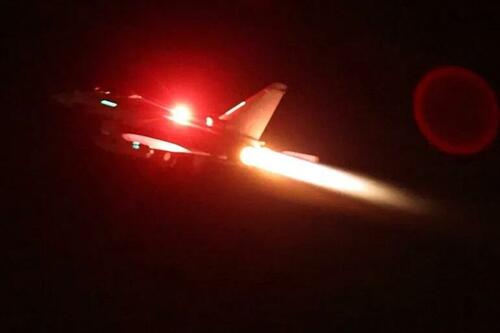
On Friday night (US time) it was revealed that the Pentagon conducted a second round of strikes against the Houthis in Yemen early Saturday morning (local), a full day following an initial operation that saw large-scale US and UK missile strikes against some 60 Houthi targets.
The follow-up strikes have been widely described as smaller in scope than the prior day's more significant operation. The White House has simultaneously tried present that it is seeking to avoid escalation.

“We will make sure we respond to the Houthis if they continue this outrageous behavior along with our allies,” President Biden said on Friday. And his national security council spokesman John Kirby sought to emphasize, "Everything we’re doing, everything we’re trying to do is to prevent any further escalation.
These newest strikes reportedly targeted a radar facility among other locations with Houthi military infrastructure. Interestingly, the Houthis starting Thursday, along with aligned regional media, claimed that it hit Western navy assets in the Red Sea - but the US and UK have not reported or disclosed any such attack or damage.
According to details from CENTCOM:
The guided missile destroyer Carney used Tomahawk missiles in the early Saturday strike "to degrade the Houthis' ability to attack maritime vessels, including commercial vessels," the U.S. Central Command said in a statement on X, formerly Twitter.
These two rounds of attacks, which included Tomahawk missiles and even submarine launched missiles, have done nothing to deter the Iran-linked Houthis.
They are now threatening "strong and effective response" as regional waters remain on edge for what comes next. The Houthis have repeatedly said they are not scared of US and UK threats. The reality too is that the Houthis have been battling Saudi-UAE-US airpower going all the way back to 2015, amid an ongoing war for control of the country.
The Houthis have published a video of an exercise simulating the takeover of an "Israeli settlement"...
המורדים החות'ים בתימן פרסמו תיעוד מתוך אימון שקיימו - בו הם מדמים השתלטות על יישוב ישראלי, לקיחת בני ערובה ותקיפה של יעדים ישראליים מהאוויר ומהקרקע@kaisos1987 pic.twitter.com/IWCHd4w0Bp
— כאן חדשות (@kann_news) January 13, 2024
The Houthis can continue bleeding Western navies given they use $20,000 drones to draw a response from $1 million anti-air interceptor missiles, which sets up a 'win-win' situation for them while keeping up pressure on Washington too chose among multiple 'bad options'.
The Guardian underscores that for this reason it's "hard to see the emboldened Houthis stopping their campaign, given their access to relatively cheap missiles and drones and desire to show resistance to the west."
On Friday night (US time) it was revealed that the Pentagon conducted a second round of strikes against the Houthis in Yemen early Saturday morning (local), a full day following an initial operation that saw large-scale US and UK missile strikes against some 60 Houthi targets.
The follow-up strikes have been widely described as smaller in scope than the prior day’s more significant operation. The White House has simultaneously tried present that it is seeking to avoid escalation.

“We will make sure we respond to the Houthis if they continue this outrageous behavior along with our allies,” President Biden said on Friday. And his national security council spokesman John Kirby sought to emphasize, “Everything we’re doing, everything we’re trying to do is to prevent any further escalation.
These newest strikes reportedly targeted a radar facility among other locations with Houthi military infrastructure. Interestingly, the Houthis starting Thursday, along with aligned regional media, claimed that it hit Western navy assets in the Red Sea – but the US and UK have not reported or disclosed any such attack or damage.
According to details from CENTCOM:
The guided missile destroyer Carney used Tomahawk missiles in the early Saturday strike “to degrade the Houthis’ ability to attack maritime vessels, including commercial vessels,” the U.S. Central Command said in a statement on X, formerly Twitter.
These two rounds of attacks, which included Tomahawk missiles and even submarine launched missiles, have done nothing to deter the Iran-linked Houthis.
They are now threatening “strong and effective response” as regional waters remain on edge for what comes next. The Houthis have repeatedly said they are not scared of US and UK threats. The reality too is that the Houthis have been battling Saudi-UAE-US airpower going all the way back to 2015, amid an ongoing war for control of the country.
The Houthis have published a video of an exercise simulating the takeover of an “Israeli settlement”…
המורדים החות’ים בתימן פרסמו תיעוד מתוך אימון שקיימו – בו הם מדמים השתלטות על יישוב ישראלי, לקיחת בני ערובה ותקיפה של יעדים ישראליים מהאוויר ומהקרקע@kaisos1987 pic.twitter.com/IWCHd4w0Bp
— כאן חדשות (@kann_news) January 13, 2024
The Houthis can continue bleeding Western navies given they use $20,000 drones to draw a response from $1 million anti-air interceptor missiles, which sets up a ‘win-win’ situation for them while keeping up pressure on Washington too chose among multiple ‘bad options’.
The Guardian underscores that for this reason it’s “hard to see the emboldened Houthis stopping their campaign, given their access to relatively cheap missiles and drones and desire to show resistance to the west.”
Loading…






